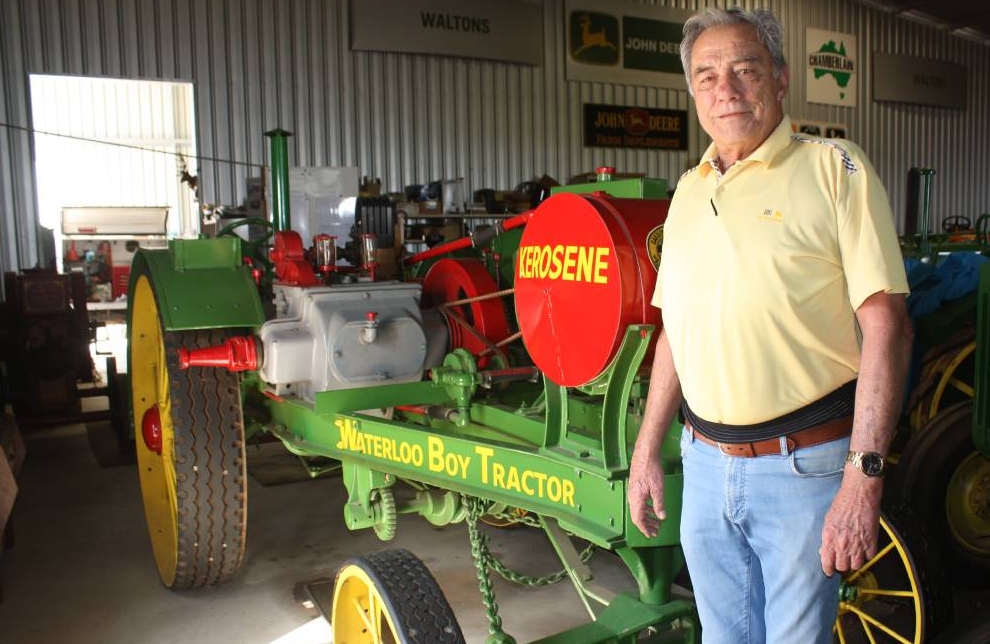John Deere will donate 400 liters of coolant to 112 tractors at the Hal Walton Tractor Museum in Carman, Western Australia.
Over the past two decades, the museum in Carman has assembled the finest collection of tractors in Australia.
The tractor collection was founded by former Carnamah Chamberlain dealership director Hal Walton long before the museum opened in 2004.
As a result of John Deere’s purchase of a 49 percent stake in the Australian tractor manufacturer Chamberlain in 1970, Hal Walton’s dealership became the Chamberlain John Deere dealership
“John Deere was founded in 1837, and Chamberlain operated from 1949 to 1987, so the history of this equipment is extensive,” Hal said.
All of the tractors in the museum are filled with antifreeze
“The machines are filled with coolant to protect the cooling systems from rust and corrosion, and because of this donation we can afford to replace all the coolant, which will last about 10-12 years.”
“We are incredibly grateful for John Deere’s support as this contribution helps us preserve the history of Chamberlain tractors made in Western Australia and John Deere imported equipment to Australia.”
John Deere Australia and New Zealand Managing Director Luke Chandler said it is an honor to support the museum, which plays a vital role in chronicling Australia’s pioneering agricultural history and tractor evolution.
“The Hal Walton Tractor Museum team has demonstrated incredible dedication in repairing, restoring and maintaining a remarkable and fascinating fleet of machines,” Luke said.
“Each of the machines in the museum served as a stepping stone to the current fleet of efficient and high-tech tractors providing modern primary production across the country.”
“Australian agriculture couldn’t exist without its machinery, so it’s important that the history of these workhorses is remembered for years to come.”
Wayne Barry, branch manager of AFGRI Equipment in Karnam, said it was an honor to support Hal and the museum’s dedicated team.
“From time to time we have loaned equipment and labor when needed,” Wayne said.
“We’re big fans of what Hal and the museum team have created for the community.
“I’m a firm believer that the past should be preserved, especially around Karnama, where machines like the ones on display in the museum were really what built and made the area what it is today.”
Wayne said the museum has been very well received by the residents of Karnama.
“It’s a great topic of discussion, and the community can be proud of it,” he said.
“It’s a great attraction that attracts visitors from all over the state. Visitors from all walks of life are interested in learning about this technique and what it means to the local community and other communities like ours in the Western Australian region.”
Hal said the most popular machine among tourists was the imported 1917 Waterloo Boy with 15.98 horsepower, which is the last tractor made by Deere and Company before the business adopted the John Deere brand with its Model D.
“Most of the machines of that era were melted down for metal during the war effort, but this Waterloo Boy escaped that duty and remained in a farmer’s barn until it was bought by a doctor in California and we were able to get it from him later.” he said.
It took an average of 100 to 150 hours to restore each piece of equipment, and the upgrade work could cost anywhere from $15,000 to $25,000.
“It’s a real thrill for all of us here when we see people walking through our museum who are amazed to see a collection of tractors that have been restored and painted to look like new – the equipment looks like it just came out. of the factory,” Hal said.
Thanks to Hal’s team, all the tractors in the museum are in working order, and you can put them in the field today. That’s a distinctive characteristic of the Carman museum, unlike other museums, where most of the pieces are dead.
The maintenance program also includes a mandatory biannual start-up of each tractor to drive through the museum grounds and grease the bearings and bushings.
“Then we clean them and polish them, then polish and clean them, then clean and polish them again,” Hal said.



